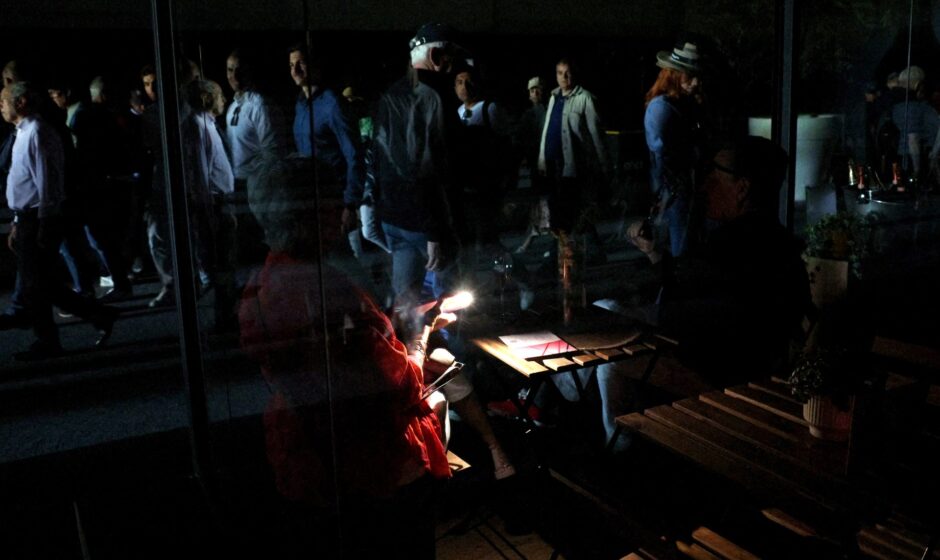Spain and Portugal have regained access to electricity after one of Europe’s worst blackouts paralysed transport systems, disrupted mobile communications and postponed medical procedures.
For almost a day from Monday to early on Tuesday, tens of millions of people were plunged into darkness. In major cities like Barcelona, Madrid and Lisbon, people were trapped in lifts, stuck on trains and unable to access the internet.
Meanwhile, queues snaked outside the few supermarkets running on backup generators as people stocked up on dried goods, water and battery-powered flashlights.
The Spanish and Portuguese governments quickly convened emergency meetings after the outage, which hit Spain and Portugal about 12:30 (10:30 GMT) on Monday and also briefly affected southern France.
Almost no one in the Iberian Peninsula, which has a population of almost 60 million people, escaped the blackout. Madrid was forced to declare a state of emergency.
Although power has been largely restored, transport remains in dire straits, with trains and flights reporting delays. No firm cause for the shutdown has yet emerged.
With the power back on, attention is turning to what caused such a widespread failure of the region’s networks.
What caused the power outage?
Portugal’s electricity provider, Redes Energeticas Nacionais (REN), said a “rare atmospheric phenomenon” had caused a severe imbalance in temperatures that led to the widespread shutdowns.
REN said: “Due to extreme temperature variations in the interior of Spain, there were anomalous oscillations in the very high voltage lines (400 kV), a phenomenon known as ‘induced atmospheric vibration’.”
The Portuguese prime minister, Luis Montenegro, also said the issue originated in Spain.
However, in a statement on Tuesday, Spain’s national meteorological office, Aemet, appeared to rule out the weather as a culprit.
“During the day of 28 April, no unusual meteorological or atmospheric phenomena were detected, and nor were there sudden variations in the temperature in our network of meteorological stations,” Aemet said.
The Spanish government said the cause of the power cut is still unknown and warned against speculation.
“My gut feeling is that multiple factors were behind the blackout,” Kang Li, smart energy systems chairman at the University of Leeds, told Al Jazeera.
“It usually takes several months for forensic grid data to be properly analysed,” he added, “though an interim report could be done in several weeks.”
Bloomberg News reported that Spain has seen a record number of hours with negative power prices in recent months as more wind and solar energy supplies the grid. Until now, however, oversupply hadn’t led to blackouts.
In 2024, renewable energy sources accounted for 56 percent of all electricity used in Spain, a record high. By 2030, that proportion is expected to reach 81 percent.
According to Li, “it’s harder to manage energy output when infrastructure is changing so quickly. A higher penetration of renewables with existing systems creates more fluctuation in the operating system.”
For his part, Spanish Prime Minister Pedro Sanchez said, “We have never had a complete collapse of the system,” explaining how Spain’s power grid lost 15 gigawatts, the equivalent of 60 percent of its national demand, in just five seconds.
While there’s no evidence yet of a cyberattack, Sanchez said he isn’t ruling anything out. He warned against speculation but said “no cause can be discredited at this point”.
Could a cyberattack have caused the blackout?
Although investigations into the cause of the outage are ongoing, Portugal’s National Cybersecurity Centre threw cold water on the idea of foul play, saying there was no sign that the outage resulted from a cyberattack.
Portuguese Prime Minister Luis Montenegro also said there was “no indication” of a cyberattack.
Speaking to reporters in Brussels, Teresa Ribera, an executive vice president of the European Commission, also ruled out sabotage. Nonetheless, the outage “is one of the most serious episodes recorded in Europe in recent times”, she said.
For now, the Spanish government said it is waiting for more information on the cause of the blackout. State officials said they hope in the coming days to know what the cause was.
Which countries were affected?
Spain and Portugal were the worst affected, but outages occurred elsewhere too:
- Spain: Urban centres such as Avila, Madrid, Murcia, Galicia, Alicante, Zaragoza, Barcelona and Seville reported widespread disruptions. The Canary and Balearic islands were not affected.
- Portugal: Lisbon and Porto experienced comparable challenges.
- Southern France: Parts of the French Basque Country saw brief power outages. But officials from the French electricity transmission network said the interruptions lasted only a few minutes.
- Morocco: Some reports suggested internet providers in Morocco struggled briefly to keep their services running because of network connections with France and the outages there.
- Greenland: Remote regions of Greenland lost access to key satellite services, including internet and telephones. Authorities said they own satellite equipment in Spain although a direct cause has not yet been established.
Has power been restored?
By mid-afternoon on Monday, Spain’s electricity operator, Red Electrica (REE), said it had started to recover voltage in the north, south and west of the country.
The recovery process was carried out gradually to avoid overloading the grid as generators linked up. Power also returned to Portugal bit by bit. By Monday night, REN said 85 of its 89 power substations were back online.
By Tuesday morning, power had almost fully returned to Spain and Portugal.
At 6:30am (04:30 GMT) more than 99 percent of energy demand in Spain had been restored, REE said. Elsewhere, power was restored overnight to 6.2 million of Portugal’s 6.5 million households.
At the city level, Madrid’s metro system said service was restored on all but one line by 8am (06:00 GMT), meaning that 80 percent of trains were operating during Tuesday morning’s rush hour.
Has Europe suffered from blackouts of this scale before?
While outages are not unheard of in Europe, the scale of Iberia’s power failure was one of the largest in recent history.
In 2019, England and Wales suffered regional blackouts amid lightning strikes at a gas-fired power plant in Bedfordshire and an offshore wind farm off the east coast of England.
A 2006 German power overload caused outages as far away as Portugal and Morocco. In 2003, a problem with a hydroelectric power line between Italy and Switzerland caused an outage across Italy for about 12 hours.
“Interconnection between countries has positive benefits as it can improve efficiency and reduce costs. … It’s always sunny or raining somewhere in Europe,” Li said.
“But”, he added “interconnected systems mean that local faults in one location can have domino effects elsewhere. Transmission lines can become overloaded.”
Li also pointed out that climate change and rising temperatures pose “increasing risks” for Spain-and-Portugal-style blackouts.
“Heat, excessive rain and wildfires all increase the risk of transmission failures. We can address this by investing more in clean energy generation to increase energy system flexibility.”
#power #outage #Spain #Portugal #Energy #News


